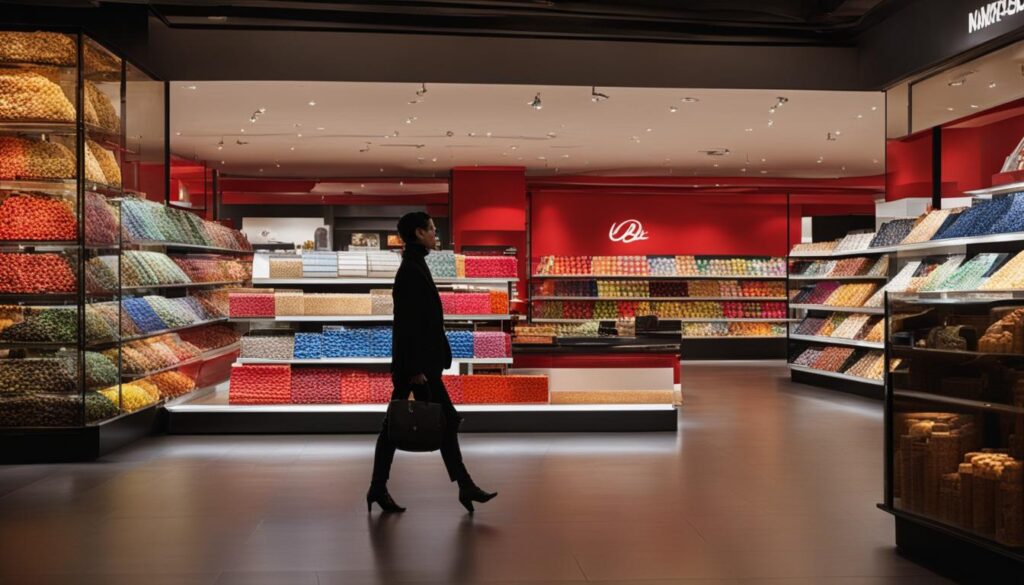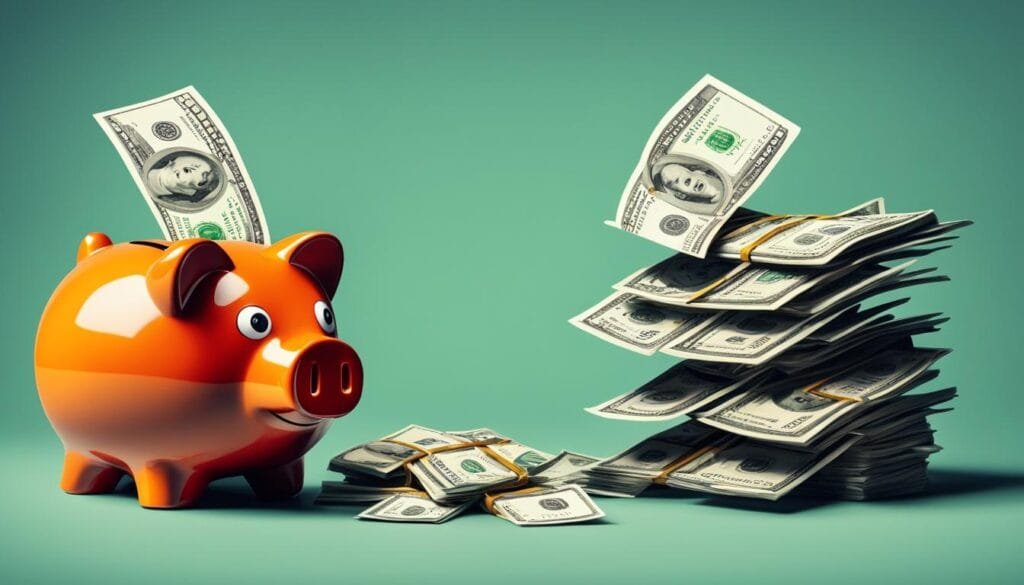Impulse buying is a common phenomenon that affects consumer buying behavior. It is driven by the desire to make spontaneous purchases without much thought. Understanding the impulse purchase cycle mentality is crucial for retailers, marketers, and consumers alike.
The impulse purchase cycle is comprised of three game-changing phases that shape buying decisions. The first phase is triggered by emotions, such as stress, boredom, or the excitement of finding a sale item. Psychological factors like low self-esteem and compulsive buying behavior can make individuals more susceptible to impulse buying.
The store environment and product placement also play a significant role in encouraging impulse buying behavior. Effective product displays and strategic positioning within the store can tempt customers to make impulsive purchases. Similarly, online shopping and brand loyalty contribute to impulsive buying.
Key Takeaways:
- Impulse buying is driven by the desire to make spontaneous purchases without much thought.
- The impulse purchase cycle consists of three phases: emotional trigger, psychological factors, and environmental influences.
- Psychological factors like low self-esteem and compulsive buying behavior make individuals more susceptible to impulse buying.
- The store environment and product placement play a significant role in encouraging impulse buying behavior.
- Online shopping and brand loyalty also contribute to impulsive purchases.
Psychological Factors in Impulse Purchases
Impulse buying behavior is influenced by various psychological factors that tap into human emotions, cognitive processes, and social inclinations. Understanding these factors can provide valuable insights into why consumers make impulsive purchases and how marketers can leverage them to their advantage.
Emotional triggers play a significant role in driving impulse buying behavior. When individuals experience certain emotions, such as excitement, boredom, or stress, they are more likely to engage in impulsive purchases. Marketers capitalize on these emotions by incorporating emotional appeals in their advertising campaigns. Through evocative storytelling, persuasive visuals, and relatable characters, marketers can tap into consumers’ emotions and create a sense of urgency or desire for a product.
Social influence is another psychological factor that can fuel impulse buying. People often seek acceptance and validation from others, leading them to make impulsive purchases to fit in with their peers or portray a certain image. This can be seen through the popularity of influencer endorsements and celebrity product endorsements, where consumers are more likely to make impulsive purchases based on the influence and reputation of others.
Cognitive biases also contribute to impulse buying behavior. One such cognitive bias is the anchoring effect, where individuals rely heavily on the initial piece of information they receive when making decisions. Marketers can leverage this bias by showcasing a higher price initially and then offering a discounted price, making the discounted price seem more appealing and driving impulsive purchases.
Impulse purchases activate the brain’s pleasure centers, releasing dopamine, a neurotransmitter associated with pleasurable sensations. This release of dopamine reinforces the action of making an impulsive purchase, leading to a potential addiction to impulse buying. Cognitive processes like reward anticipation and the desire for instant gratification drive individuals to engage in impulsive purchases repeatedly.
“Emotional triggers, social influence, and cognitive biases all play a role in guiding consumers towards making impulsive purchases. By understanding these psychological factors, marketers can effectively design strategies that tap into consumers’ emotions and motivations, triggering impulsive buying behavior.”
| Psychological Factors | Impact on Impulse Buying |
|---|---|
| Emotional Triggers | Emotions drive impulsive purchases; marketers leverage emotional appeals to create a sense of urgency and desire. |
| Social Influence | Consumers are driven to make impulsive purchases to fit in with peers and portray a certain image. |
| Cognitive Biases | Biases like the anchoring effect lead to irrational decisions and increase the likelihood of impulse buying. |
| Pleasure Centers in the Brain | Impulse purchases activate pleasure centers, releasing dopamine and potentially leading to addictive behavior. |
The Influence of Marketing Tactics in Impulse Buying
Marketers are well aware of the powerful impact of impulse buying on consumer behavior. By understanding the impulsive buying decision-making process and the psychological factors that drive impulse purchases, marketers can strategically leverage various tactics to encourage impulsive buying behavior.
Sense of Urgency
Creating a sense of urgency is a common marketing strategy to motivate impulse purchases. Limited-time offers, exclusive deals, or highlighting low stock quantities can trigger a fear of missing out (FOMO) and prompt consumers to make impulsive buying decisions. By emphasizing scarcity and immediacy, marketers tap into impulsive tendencies and exploit the impulsive buying patterns of consumers.
Emotional Appeals
Psychological factors play a significant role in impulse purchases. Emotional triggers such as desire, happiness, or excitement can lead consumers to make impulsive buying decisions. Marketers craft persuasive messages and imagery that evoke strong emotional responses, effectively influencing impulsive behavior.

Easy Decision-Making
Streamlining the decision-making process can increase impulse purchases. Marketers focus on providing clear and concise product information, making it easier for consumers to evaluate and understand the value of the product. Additionally, simplifying the checkout process by minimizing steps and offering convenient payment options can further facilitate impulsive buying decisions.
Social Proof
Social proof is a powerful psychological factor in impulse purchases. Marketers leverage social proof by showcasing product popularity or positive reviews. By highlighting the endorsement or approval of others, marketers create a sense of trust and credibility, encouraging consumers to follow suit and make impulsive buying decisions.
By implementing these tactics, marketers maximize their chances of influencing impulsive buying behaviors and capitalizing on the impulsive buying patterns of consumers. However, it is important for consumers to be mindful of these tactics and make conscious, informed buying decisions.
Managing Impulse Buying
Impulse buying can have significant financial consequences, making it crucial to develop strategies for managing this behavior. By adopting a proactive approach, individuals can avoid impulsive purchases and maintain better control over their finances.
Creating a Shopping List and Meal Plan
One effective strategy for managing impulse buying is to create a shopping list and meal plan. By writing down the items needed and sticking to the list, individuals can reduce the chances of making impulsive purchases. Similarly, planning meals in advance helps to avoid unnecessary trips to the store, minimizing the exposure to tempting impulse-buy items.
Using Debit Cards Instead of Credit
Switching from credit cards to debit cards is another helpful approach. Unlike credit cards, which allow for deferred payment, debit cards deduct funds directly from the individual’s bank account, providing a real-time overview of available funds. This increased visibility can deter impulsive purchases by reminding individuals of their financial limitations.
Implementing the 24-Hour Rule
The 24-hour rule is a powerful technique in managing impulse buying. Instead of immediately making a purchase, individuals commit to waiting 24 hours before finalizing the decision. This waiting period allows time for rational thought and reflection, reducing the influence of impulsive emotions on the buying process.
Being Mindful of Emotional Triggers
Awareness of emotional triggers is vital in managing impulse buying. By recognizing and understanding personal emotional vulnerabilities, individuals can better safeguard against impulsive purchases. Practicing mindfulness and self-reflection helps individuals identify the underlying reasons for their impulsive behavior, enabling them to develop healthier coping mechanisms and find more sustainable alternatives.
Tracking Spending Habits
Regularly monitoring and tracking spending habits is an effective way to manage impulse buying. By keeping a record of all purchases, individuals gain insights into their spending patterns and can identify areas where impulsive buying occurs most frequently. This knowledge empowers individuals to make conscious changes and set realistic spending goals to curb impulsive tendencies.

“To conquer impulse buying, it is essential to take control over your spending habits, strengthen your willpower, and practice mindful consumption.”
By implementing strategies like creating shopping lists, using debit cards, practicing the 24-hour rule, being mindful of emotional triggers, and tracking spending habits, individuals can successfully manage their impulse buying mindset. Taking control over impulsive behavior not only helps protect personal finances but also promotes a healthier and more intentional approach to consumerism.
The Impact of Impulse Buying in Retail and Ecommerce
Impulse buying is a powerful force that drives significant revenue for the retail industry. Retailers strategically design their physical spaces and online platforms to entice customers into making impulse purchases. The allure of limited-time offers, attractive displays, and persuasive marketing tactics can create an irresistible temptation for consumers.
During holidays and seasonal changes, impulse spending tends to rise as people are more inclined to indulge in spontaneous purchases. As consumers, we’re often influenced by the excitement and festive spirit, which can lead us to make impulse buying decisions.
The rise of social media platforms and ecommerce has further fueled the prevalence of impulse buying. Social media provides a constant stream of product recommendations, flash sales, and enticing offers, all designed to trigger impulsive buying behavior. Influencers play a significant role in promoting products, showcasing their own indulgences, and creating a sense of urgency. This influencer effect is particularly prominent among younger demographics who seek validation and connection through social media.
Targeted ads are another powerful tool in the realm of impulse buying. Brands leverage user data and analytics to deliver tailored ads to potential buyers, increasing the chances of triggering impulsive purchases. These highly personalized advertisements capitalize on a customer’s interests, preferences, and previous buying behavior, enhancing the temptation to make spontaneous buying decisions.
The convenience and accessibility of mobile shopping apps have revolutionized the way we shop. With just a few taps on our smartphones, we can browse and buy products instantly. One-click buying options and saved payment information remove any friction in the buying process, making it even easier for consumers to succumb to impulsive purchases.

This image represents the growing trend of impulse buying, fueled by the rise of social media and ecommerce.
In conclusion, impulse buying trends have undergone significant transformations in the retail industry. The combined influence of social media, targeted ads, and convenient ecommerce platforms has amplified the opportunities for impulse buying. Consumers are lured by tempting offers, influencer endorsements, and the ease of online shopping. As a result, retailers continue to capitalize on these trends, strategically creating an environment that inspires and ultimately drives impulsive purchases.
How Does the Impulse Purchase Cycle Mentality Tie into the Effects of Retail Therapy?
Many are unaware of the bizarre truth retail therapy. The impulse purchase cycle mentality is a key factor in this phenomenon. When people shop impulsively, the rush of buying provides temporary relief. This ties into the effects of retail therapy, where shopping is used to alleviate stress or improve mood.
Conclusion
Understanding the impulse purchase cycle mentality is crucial for both consumers and retailers. By being aware of emotional triggers, psychological factors, and marketing tactics, individuals can make more informed buying decisions and effectively manage impulse buying.
Retailers play a significant role in encouraging impulse buys, but they should also consider the potential impact on consumer finances. Balancing the occasional impulse purchase with financial stability is key. It’s important for individuals to be mindful of their spending habits and emotional triggers to avoid falling into a cycle of impulsive buying.
Managing impulse buying requires knowledge and awareness. By implementing strategies like having a shopping list, waiting 24 hours before making a purchase, and using a debit card instead of credit, individuals can control their impulse buying behavior.
With a deeper understanding of the impulse purchase cycle mentality and proactive efforts towards managing impulse buying, both consumers and retailers can navigate this complex phenomenon while making wiser choices.
FAQ
What is the impulse purchase cycle mentality?
The impulse purchase cycle mentality refers to the psychological and emotional processes that drive consumers to make impulsive purchases without careful consideration.
What factors contribute to impulse buying behavior?
Impulse buying behavior is influenced by psychological factors, including emotions, social influence, and cognitive biases.
How do marketers leverage impulse buying?
Marketers utilize tactics such as creating a sense of urgency, using emotional appeals, and simplifying the decision-making process to encourage impulse purchases.
How can impulse buying be managed?
Strategies like having a shopping list, implementing the 24-hour rule, and being mindful of emotional triggers can help manage impulse buying.
What is the impact of impulse buying in retail and ecommerce?
Impulse buying is a significant revenue generator for the retail industry. It has been further fueled by the rise of social media platforms, influencers, and the convenience of mobile shopping apps.
Source Links
- https://1seo.com/blog/three-game-changing-phases-of-the-impulse-purchase-cycle-everyone-must-know/
- https://medium.com/@kornelijakazlauskas/7-phases-of-impulse-buying-cycle-understanding-purchase-psychology-behind-it-583cbe42c99
- https://www.linkedin.com/pulse/psychology-behind-impulse-buying-how-leverage-marketing-jain

